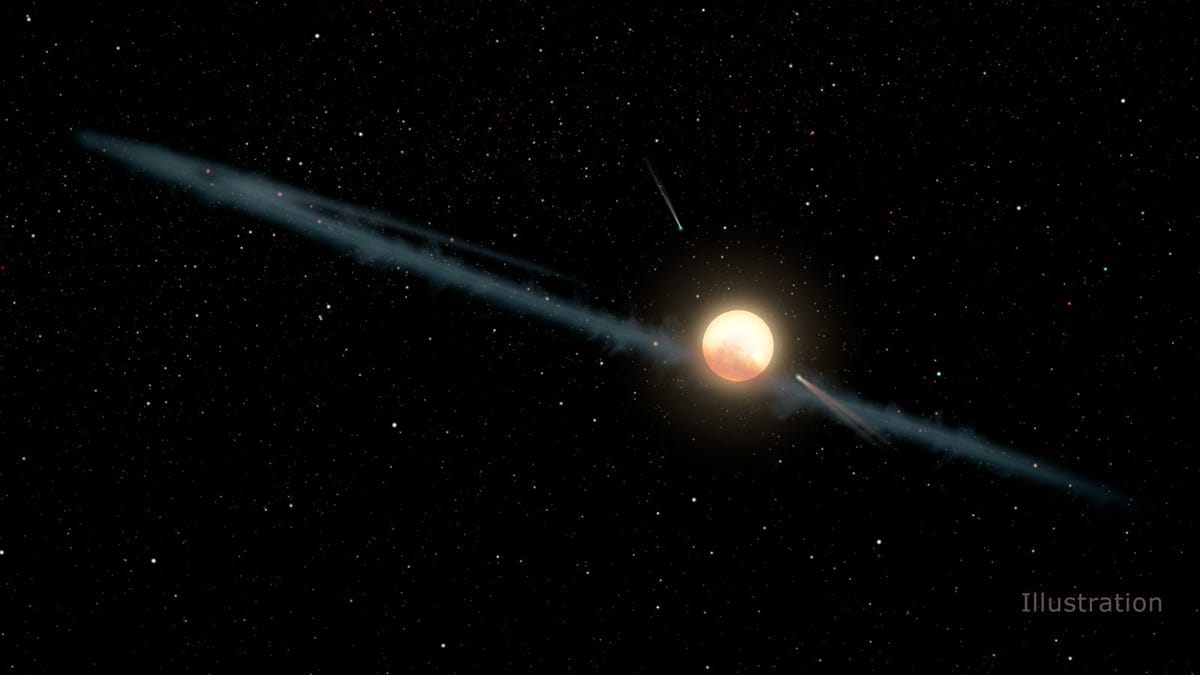Teen scientist checks for alien lasers around famously weird star
A high school junior dug deep into the data on a mysteriously dimming star to search for evidence of a highly advanced civilization.

This illustration show's an artist's vision of what Tabby's Star might look like with a surrounding ring of dust.
Boyajian's Star (also known as Tabby's Star or KIC 8462852) first made headlines in 2015 when it was suggested alien megastructures might explain its strange behavior: the star's brightness seemed to randomly rise and fall over time.
Since then, a number of telescopes including the recently deactivated Kepler Space Telescope have been pointed at the star to try to better understand what's really happening there.
David Lipman was captivated enough by the so-called "alien megastructures star" in 2016 that he began analyzing publicly available observations of Boyajian's Star from the Automated Planet Finder Telescope (APF) at California's Lick Observatory.
But Lipman isn't a professional astronomer. At the time, he was a junior at Kehillah Jewish High School in Palo Alto, California, looking into the data sets for a school science project.
"(I'm) looking for candidate laser signals," Lipman explained in the below interview filmed at Lick. "I've written an algorithm that basically looks through all of the spectra that Breakthrough Listen has recorded."
Breakthrough Listen searches galaxies for radio signals and laser transmissions in the hopes of finding extra-terrestrial intelligence. Part of a $100 million series of initiatives announced in 2015 by Russian-Israeli billionaire Yuri Milner and physicist Stephen Hawking, the project attracted the attention of Facebook CEO Mark Zuckerberg, who sits on its board.
Lipman began a correspondence with University of California Berkeley scientists Howard Isaacson and Steve Croft, who work on Breakthrough Listen and the APF program, and was eventually invited to work directly with the scientists as part of a summer internship.
Lipman analyzed APF data, looking for any signs of uber powerful lasers straight out of science fiction -- the kind a highly advanced alien civilization might use for communication or propelling spaceships.
"He quickly became familiar with a lot of background material to the extent that the team could converse with him at a highly technical level about his work," Croft said. "Most students his age working on science problems are tackling questions where the correct answer is given in the back of the textbook. In contrast, David is doing original research that is helping us to advance our capacity to answer one of the biggest questions in science: Are we alone in the universe?"
Lipman's search didn't turn up any evidence of alien lasers, but through continued collaboration with Isaacson and other researchers, the results have now been accepted for publication in a peer-reviewed journal, with Lipman as the lead author.
"His thorough analysis of this one object will form the groundwork for the analysis of the hundreds of other targets," Croft wrote in a blog post.
The paper will be published in Publications of the Astronomical Society of the Pacific and a pre-print draft can be read here.
It's been three years since Boyajian's Star first made a stir, and Lipman is now an 18-year-old freshman at Princeton University. He told me via email that he's thinking of majoring in physics, but is still exploring other options.
"I'm very passionate about machine learning and its potential benefits for science and society... (I) have some ideas on how to use neural networks to more accurately analyze spectra to identify artificial signals."
Meanwhile, other teams of astronomers continue to watch Boyajian's Star closely, and the leading explanation today is that clouds of space dust, not huge alien construction projects, are blocking its light in unusual ways.
But the distant sun still remains an intriguing candidate to check for signs of extra-terrestrial life, just in case. In fact, the recently launched Transiting Exoplanet Survey Satellite (TESS) is scheduled to take a closer look in the new year.
NASA turns 60: The space agency has taken humanity farther than anyone else, and it has plans to go further.
Crowd Control: A crowdsourced science fiction novel written by CNET readers.

